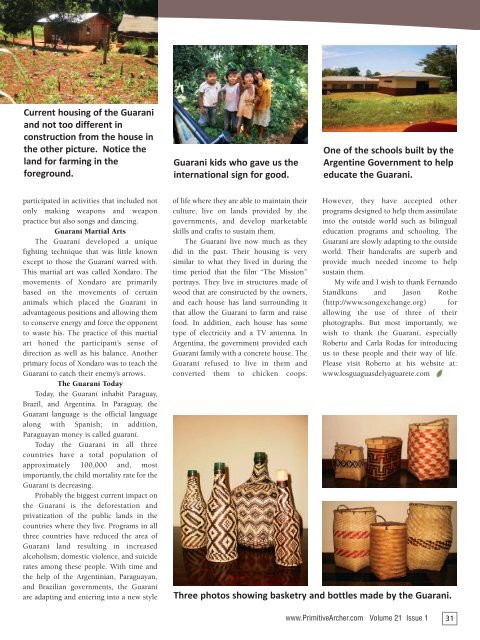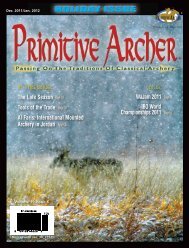In This Issue: plus: - Primitive Archer Online
In This Issue: plus: - Primitive Archer Online
In This Issue: plus: - Primitive Archer Online
You also want an ePaper? Increase the reach of your titles
YUMPU automatically turns print PDFs into web optimized ePapers that Google loves.
Current housing of the Guarani<br />
and not too different in<br />
construction from the house in<br />
the other picture. Notice the<br />
land for farming in the<br />
foreground.<br />
participated in activities that included not<br />
only making weapons and weapon<br />
practice but also songs and dancing.<br />
Guaraní Martial Arts<br />
The Guaraní developed a unique<br />
fighting technique that was little known<br />
except to those the Guaraní warred with.<br />
<strong>This</strong> martial art was called Xondaro. The<br />
movements of Xondaro are primarily<br />
based on the movements of certain<br />
animals which placed the Guaraní in<br />
advantageous positions and allowing them<br />
to conserve energy and force the opponent<br />
to waste his. The practice of this martial<br />
art honed the participant’s sense of<br />
direction as well as his balance. Another<br />
primary focus of Xondaro was to teach the<br />
Guaraní to catch their enemy’s arrows.<br />
The Guaraní Today<br />
Today, the Guaraní inhabit Paraguay,<br />
Brazil, and Argentina. <strong>In</strong> Paraguay, the<br />
Guaraní language is the official language<br />
along with Spanish; in addition,<br />
Paraguayan money is called guaraní.<br />
Today the Guaraní in all three<br />
countries have a total population of<br />
approximately 100,000 and, most<br />
importantly, the child mortality rate for the<br />
Guaraní is decreasing.<br />
Probably the biggest current impact on<br />
the Guaraní is the deforestation and<br />
privatization of the public lands in the<br />
countries where they live. Programs in all<br />
three countries have reduced the area of<br />
Guaraní land resulting in increased<br />
alcoholism, domestic violence, and suicide<br />
rates among these people. With time and<br />
the help of the Argentinian, Paraguayan,<br />
and Brazilian governments, the Guaraní<br />
are adapting and entering into a new style<br />
Guarani kids who gave us the<br />
international sign for good.<br />
of life where they are able to maintain their<br />
culture, live on lands provided by the<br />
governments, and develop marketable<br />
skills and crafts to sustain them.<br />
The Guaraní live now much as they<br />
did in the past. Their housing is very<br />
similar to what they lived in during the<br />
time period that the film “The Mission”<br />
portrays. They live in structures made of<br />
wood that are constructed by the owners,<br />
and each house has land surrounding it<br />
that allow the Guaraní to farm and raise<br />
food. <strong>In</strong> addition, each house has some<br />
type of electricity and a TV antenna. <strong>In</strong><br />
Argentina, the government provided each<br />
Guaraní family with a concrete house. The<br />
Guaraní refused to live in them and<br />
converted them to chicken coops.<br />
One of the schools built by the<br />
Argentine Government to help<br />
educate the Guarani.<br />
However, they have accepted other<br />
programs designed to help them assimilate<br />
into the outside world such as bilingual<br />
education programs and schooling. The<br />
Guaraní are slowly adapting to the outside<br />
world. Their handcrafts are superb and<br />
provide much needed income to help<br />
sustain them.<br />
My wife and I wish to thank Fernando<br />
Standkuns and Jason Rothe<br />
(http://www.songexchange.org) for<br />
allowing the use of three of their<br />
photographs. But most importantly, we<br />
wish to thank the Guaraní, especially<br />
Roberto and Carla Rodas for introducing<br />
us to these people and their way of life.<br />
Please visit Roberto at his website at:<br />
www.losguaguasdelyaguarete.com<br />
Three photos showing basketry and bottles made by the Guarani.<br />
www.<strong>Primitive</strong><strong>Archer</strong>.com Volume 21 <strong>Issue</strong> 1 31



